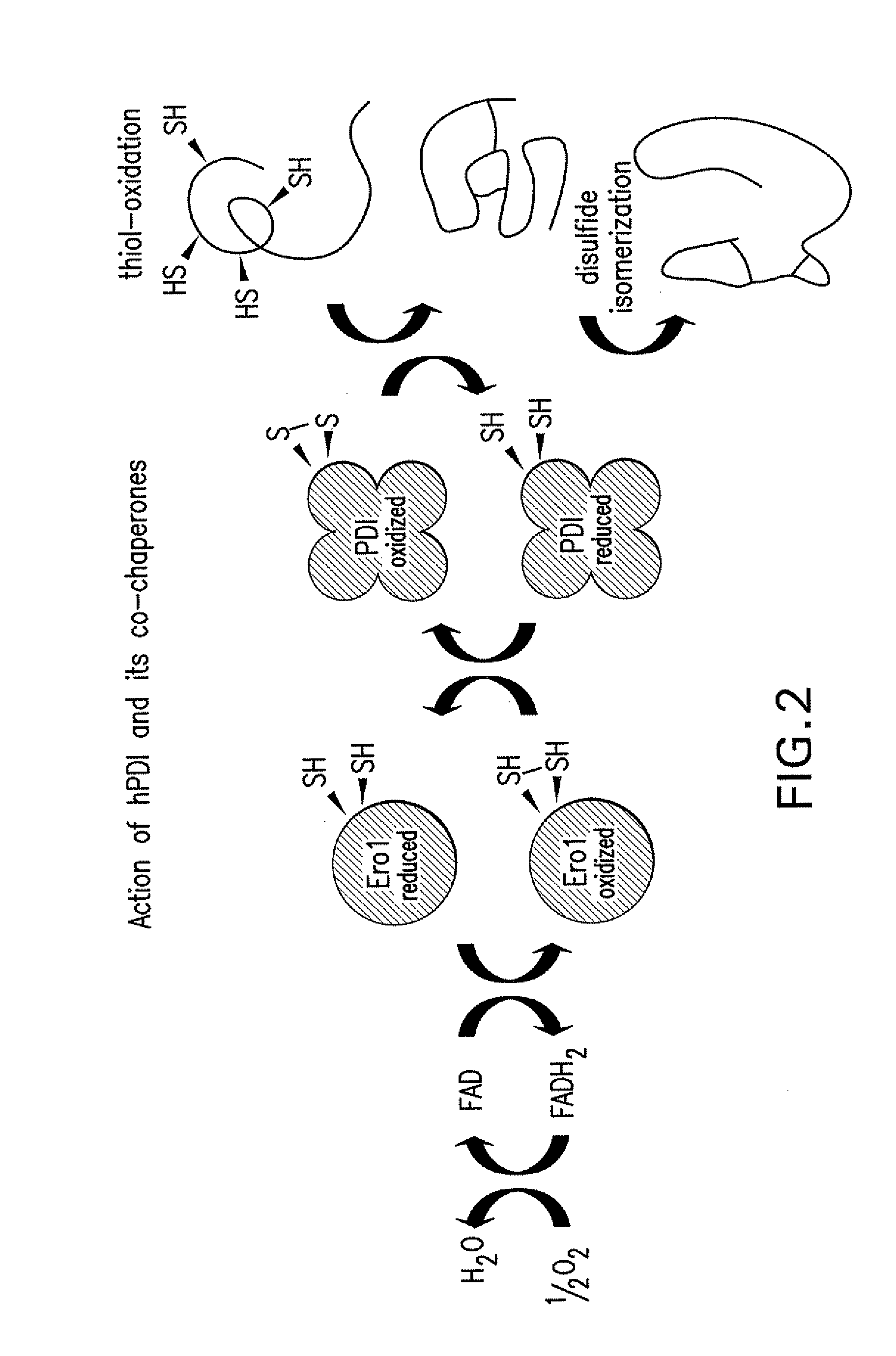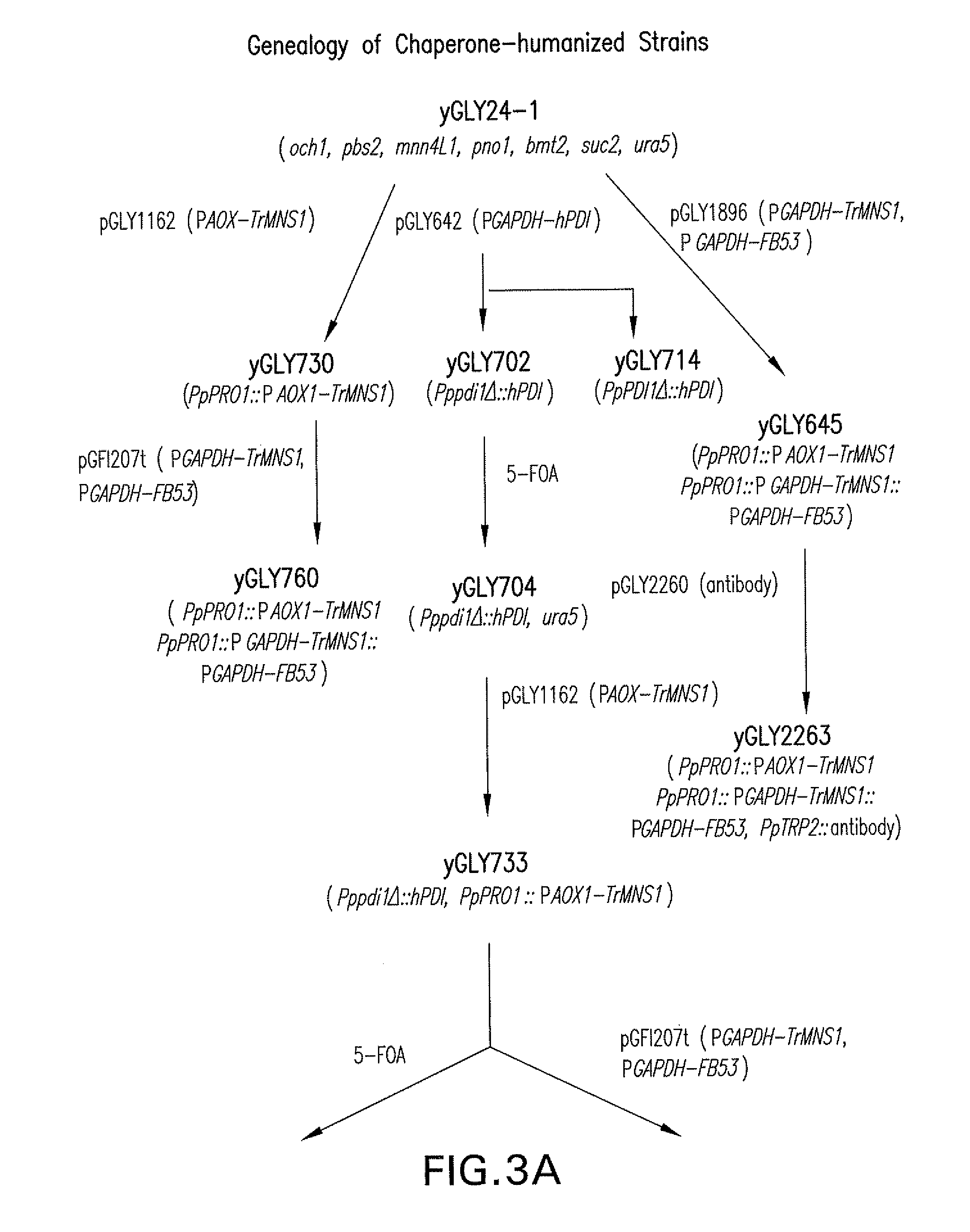Vectors and yeast strains for protein production
a technology applied in the field of vectors and yeast strains for protein production, can solve the problems of inability to produce cells, often proved non-viable or low-producing cells, rendering them inappropriate for commercial use, etc., and achieve the effect of reducing or eliminating the function of an endogenous gene encoding a chaperone protein, improving the expression of recombinant proteins in recombinant host cells, and increasing expression of recombinant proteins
- Summary
- Abstract
- Description
- Claims
- Application Information
AI Technical Summary
Benefits of technology
Problems solved by technology
Method used
Image
Examples
example 1
[0150]This example shows that expression of heterologous human proteins in Pichia pastoris was enhanced by using host cells in which the gene encoding the endogenous PDI1 has been inactivated and replaced with an expression cassette encoding the human PDI. The example further shows that these host cells produced recombinant antibodies that had reduced O-glycosylation.
[0151]Construction of expression / integration plasmid vector pGLY642 comprising an expression cassette encoding the human PDI protein and nucleic acid molecules to target the plasmid vector to the Pichia pastoris PDI1 locus for replacement of the gene encoding the Pichia pastoris PDI1 with a nucleic acid molecule encoding the human PDI was as follows and is shown in FIG. 8. cDNA encoding the human PDI was amplified by PCR using the primers hPDI / UP1: 5′ AGCGCTGACGCCCCCGAGGAGGAGGACCAC 3′ (SEQ ID NO: 1) and hPDI / LP-PacI: 5′ CCTTAATTAATTACAGTTCATCATGCACAGCTTTCTGATCAT 3′ (SEQ ID NO: 2), Pfu turbo DNA polymerase (Stratagene, L...
example 2
[0193]A benefit of the strains shown in Tables 2 and 3 is that making yeast strains that have replaced the endogenous PDI1 gene with an expression cassette that encodes a heterologous PDI not only effects an increase in protein yield but also effects a decrease in both the number of attached O-glycans (occupancy) and a decrease in undesired Man2 O-glycan structures. Recombinant proteins produced in yeast often display aberrant O-glycosylation structures relative to compositions of the same glycoprotein produced from mammalian cell culture, reflecting the significant differences between the glycosylation machinery of mammalian and yeast cells. These aberrant structures may be immunogenic in humans.
[0194]The inventors noted that host cells of Pichia pastoris carrying the human PDI gene in place of the endogenous Pichia pastoris PDI1 gene were strain more resistant to PMT protein inhibitors (See published International Application No. WO2007061631), suggesting that these strains might ...
example 3
[0216]This example describes a chimeric BiP gene, in which the human ATPase domain is replaced by the ATPase domain of Pichia pastoris KAR2, fused to the human BiP peptide binding domain, under the control of the KAR2, or other ER-specific promoter from Pichia pastoris. The nucleotide and amino acid sequences of the human BiP are shown in Table 11 as SEQ ID NOs: 55 and 56, respectively. The nucleotide and amino acid sequences of the chimeric BiP are shown in Table 11 as SEQ ID NOs: 57 and 58, respectively. Further improvements in yield may be obtained by combining the replacement of the endogenous PDI1 gene, as described above, with the use of chimeric BiP and human ERdj3 (SEQ D NOs: 76 and 77, respectively).
PUM
| Property | Measurement | Unit |
|---|---|---|
| OD | aaaaa | aaaaa |
| temperature | aaaaa | aaaaa |
| temperature | aaaaa | aaaaa |
Abstract
Description
Claims
Application Information
 Login to View More
Login to View More - R&D
- Intellectual Property
- Life Sciences
- Materials
- Tech Scout
- Unparalleled Data Quality
- Higher Quality Content
- 60% Fewer Hallucinations
Browse by: Latest US Patents, China's latest patents, Technical Efficacy Thesaurus, Application Domain, Technology Topic, Popular Technical Reports.
© 2025 PatSnap. All rights reserved.Legal|Privacy policy|Modern Slavery Act Transparency Statement|Sitemap|About US| Contact US: help@patsnap.com



